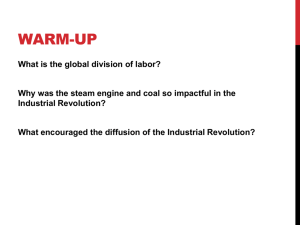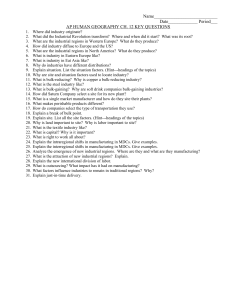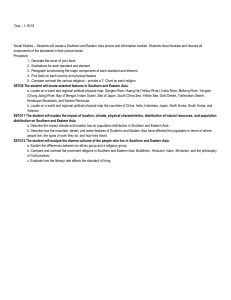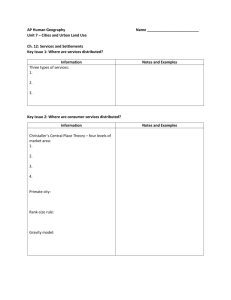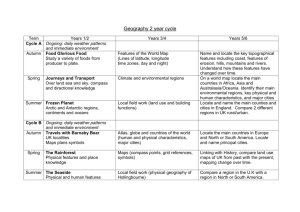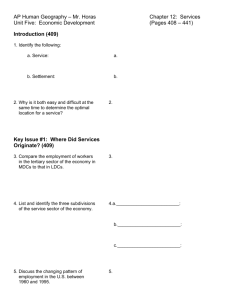File
advertisement
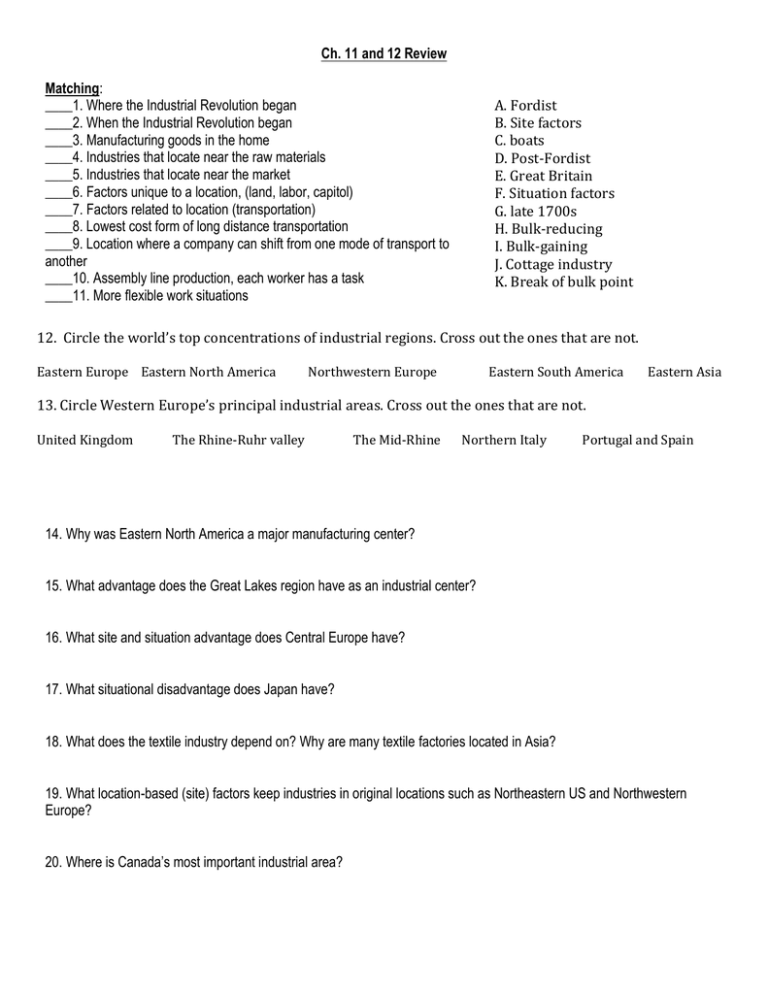
Ch. 11 and 12 Review Matching: ____1. Where the Industrial Revolution began ____2. When the Industrial Revolution began ____3. Manufacturing goods in the home ____4. Industries that locate near the raw materials ____5. Industries that locate near the market ____6. Factors unique to a location, (land, labor, capitol) ____7. Factors related to location (transportation) ____8. Lowest cost form of long distance transportation ____9. Location where a company can shift from one mode of transport to another ____10. Assembly line production, each worker has a task ____11. More flexible work situations A. Fordist B. Site factors C. boats D. Post-Fordist E. Great Britain F. Situation factors G. late 1700s H. Bulk-reducing I. Bulk-gaining J. Cottage industry K. Break of bulk point 12. Circle the world’s top concentrations of industrial regions. Cross out the ones that are not. Eastern Europe Eastern North America Northwestern Europe Eastern South America Eastern Asia 13. Circle Western Europe’s principal industrial areas. Cross out the ones that are not. United Kingdom The Rhine-Ruhr valley The Mid-Rhine Northern Italy Portugal and Spain 14. Why was Eastern North America a major manufacturing center? 15. What advantage does the Great Lakes region have as an industrial center? 16. What site and situation advantage does Central Europe have? 17. What situational disadvantage does Japan have? 18. What does the textile industry depend on? Why are many textile factories located in Asia? 19. What location-based (site) factors keep industries in original locations such as Northeastern US and Northwestern Europe? 20. Where is Canada’s most important industrial area? Matching: ____21. Area of the city where retail and office activities are clustered ____22. Burying the dead ____23. Protecting the group’s assets ____24. Farm buildings, homes, and churches close together ____25. Retail, education, health and hospitality ____26. Area surrounding a service from which customers come ____27. Minimum number of people needed to support a service ____28. Maximum distance people are willing to travel for a service ____29. Industries that sell their products or services primarily to outside consumers ____30. Industries that sell their products primarily to consumers in the community A. Basic industries B. Hinterland C. Religious reason for the origin of settlements D. Range E. Threshold F. Non-basic industries G. Political reason for the origin of settlements H. CBD I. Consumer services J. Clustered rural settlement 31. Because of high land costs, the American CBD has lots of what type of buildings? 32. Where would retail services locate in a skyscraper? 33. What was the purpose of the French long-lot system? 34. Where are clustered rural settlements found in America? 35. Where are plantation settlements found in America? 36. Where is the best location for a service in a linear community? 37. What shape do geographers use to represent market areas? 38. Explain Rank Size Rule: 39. Explain Primate Cities: FRQ: Describe a bulk gaining industry. Where would it locate near? Why? Describe a bulk reducing industry. Where would it locate near? Why? Describe a country with Primate City. What are 2 positive effects? What are 2 negative effects? Describe a country with Rank-size rule. What is 1 positive effect? What is 1 negative effect? Is the automobile industry bulk-gaining or bulk-reducing? Why? Where would the automobile industry locate near? What country has the biggest market for automobiles? Why would foreign countries open up automobile factories in the US?
